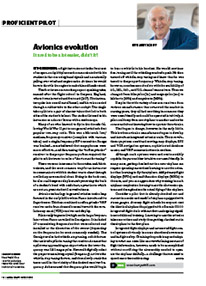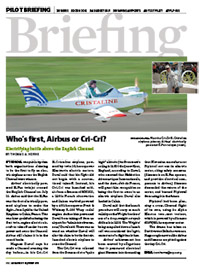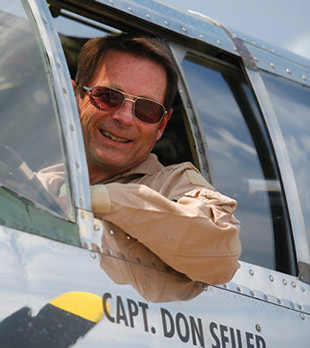 Have complicated modern avionics affected airmanship? Barry Schiff’s take on the subject struck a chord with readers.
Have complicated modern avionics affected airmanship? Barry Schiff’s take on the subject struck a chord with readers.
While reading Barry Schiff’s piece “Avionics Evolution,” I found I couldn’t agree more with his concluding paragraph.
When I started flying in 1968, my training airplane was a Cessna 140. On one of my first lessons, I looked toward the bottom of the instrument panel and noticed a box-like contraption. I asked my instructor what it was. He said, “It’s a radio. Don’t touch it!” Needless to say, the box stayed cold and silent for many lessons.
I think I had about 30 hours in the airplane before he taught me how to turn on the radio and use it. It was a “coffee grinder” Narco Superhomer or something similar.
The important point is that he wanted to teach me to fly. Talking on the radio and using a VOR came much later.
During 40 years making my living as a pilot, 35 as an airline pilot, I often found myself thankful that my first instructor was a hard taskmaster who taught me to fly. All the rest of those wonderful avionics miracles helped immensely, but I always knew I needed to properly fly the airplane.
Alan Edgren
AOPA 1465245
Punta Gorda, Florida
Dogfight: Glass or steam?
I enjoyed the October “Dogfight” over glass or steam cockpits. I am one of those strange breed of pilots who learned to fly at 55 years old in a G1000-equipped Cessna 172. That’s all I ever knew and that is what I subsequently bought.
I did most of my instrument training elsewhere and I did it in a 1972 Cessna 172, which was all steam gauges, stacked radios, et cetera. Pure vintage stuff. But I finished up and did my instrument checkride in a G1000. (I passed.)
In hindsight, I actually found the steam gauges easier to fly IFR. Headings and altitudes were easier to hold for the simple reason that the instruments were not as sensitive. There was no “chasing the tape,” and keeping the needles centered seemed more intuitive than chasing the ball.
Less information; more ability for my simple mind to focus.
That being said, would I trade the glass panel in my present Cessna 182 for steam gauges? No way! But I think (I hope) I am more adept at handling that information overload now than I was as a student pilot.
Rich Iott
AOPA 4560736
Monclova, Ohio
In top form
I enjoyed your article regarding AOPA’s “Reimagined” program, and the restoration/repurposing of those (dare I say vintage) personal aircraft. Where did the time go? It doesn’t seem all that long ago.
I had the great fortune of learning how to fly in ’83 to ’84 at my local FBO. I was just 25, and my wife, Donna, surprised me with a Piper “Blue Sky Solo” course. I had the time of my life. We had little money for this, and at the end of earning my private ticket we simply didn’t have the money to go on. A day hasn’t gone by where I haven’t cast my eyes skyward and wished it were me as an airplane flies over. However, with the prospect of further education costs, purchasing a home, et cetera, buying, renting, or even occasional flying was simply out of the financial equation.
Now, at 57, my wife and I look back at the past 30 years, and realize we’ve both been very successful and grateful. Just starting to contemplate retirement, blowing the dust off my old logbook seems to be a possibility, especially with the emergence of “older” but solidly refurbished aircraft like Two-Uniform-Charlie.
Maybe it’s a sign, but I recently renewed my membership to AOPA, purchased some reading material to help bring me up to date on flying, and have made a couple of trips to the local FBO to investigate what is needed to bring me back to currency. I have even gone as far to peruse Trade-A-Plane to see what the realities are. I was pleasantly surprised to read your “just-in-time” article. That brought me that significant step closer to again establishing myself as PIC.
I’ve even felt confident enough that I’ve entered AOPA’s You Can Fly sweepstakes; you never know, someone’s going to get the call!
Not only are these old aircraft being reimagined, but I have to believe that many an old pilot will be, too.
Tom Leetz
AOPA 5314952
Elgin, Illinois
Gone, baby, gone
In your story on some poor aircraft designs, you remark of the nonstandard flap/gear switches in Beech Barons and Bonanzas that were finally corrected in 1984 and later- year models. While true for the Model 33, 35, and 36 Bonanzas and Model 55 and 58 Barons, it is inaccurate for the Model 58P and 58TC, which commenced deliveries in 1976. Because those aircraft had new type certificates under different regulations (Part 23, I believe) the gear and flap switches were in the standard location (gear on left, flap on right). I owned for a short time a 1979 Model 35 (nonstandard) and a 1977 Model 58TC (standard gear/flap switches) at the same time, and it took a little extra diligence in their operation. Both were fantastic airplanes exceeding the POH airspeeds at selected power settings, especially the 58TC.
One interesting note on the TC. Since it was basically an unpressurized P Baron, it had an amazingly strong airframe. It had thicker skins and a stronger spar so it didn’t come under the spar AD of the standard Model 58. A demonstration of that strong airframe was the TC’s maneuvering speed, which was an astounding 170 knots. I normally cruised at about 61 to 62 percent power at 12,000 to 14,000 feet at an indicated 165 to 168 knots (at 5,600 to 5,800 pounds). In other words, I always cruised below maneuvering speed.
Larry Weitzman
AOPA 504833
Placerville, California
Thanks for a most informative article (“Savvy Maintenance: Tectonic Shifts”). It’s so well written that I’d have finished if the subject were knitting supplies.
Gary Mello
AOPA 838454
Cambridge, Massachusetts
 Clarification
Clarification
I am sure that by now you have been made aware that the Wright brothers did not use a drop weight catapult for their 1903 flights at Kitty Hawk (“Who’s First, Airbus or Cri-Cri?” September AOPA Pilot). They launched by the power of the Wright Flyer engine alone. Later, back in Dayton, they used a catapult system so they could get airborne in a much shorter distance.
David Bormuth
AOPA 1247165
Plain City, Ohio
You got us there, but Cri-Cri pilot Hugues Duval invoked the catapult as a way of justifying the legitimacy of his flight as the first Channel crossing by an all-electric airplane. And while the Wrights set many records on their catapult-launched flights in Dayton, it may be a failed analogy for the Cri-Cri. After all, the Fédération Aéronautique Internationale isn’t in the business of judging “firsts,” just distance and speed records. —Ed.
Errata
In the October 2015 AOPA Pilot, there were two errors in “To Infinity and Beyond.” SpaceShipOne is not known as Launcher One; Launcher One is not a part of the human spaceflight program. Also, there are “well more than one dozen female ticket holders,” according to Virgin Galactic’s Will Pomerantz, who says Virgin does not reveal the exact numbers, but female ticket holders are significantly more than one dozen as stated in the story. AOPA Pilot regrets the errors.
In “Diesel Rounds the Bend,” October 2015 AOPA Pilot, we incorrectly identified who flew a Cirrus SR22 powered by a Graflight V-8 to EAA AirVenture 2014. Dick Rutan did not fly that aircraft to AirVenture.
We welcome your comments. Editor, AOPA Pilot, 421 Aviation Way, Frederick, Maryland 21701 or email ([email protected]). Letters may be edited for length and style before publication.
What’s on your aviation bucket list?
Learning to fly or increasing your certificates and ratings 27%
Owning a certain type of airplane 26%
Flying to a new destination 28%
A new flight experience 10%
Other 8%
Aviation eBrief poll
 Hangar talk
Hangar talk
“I was honored just to get the chance to sit in the pilot seat of a B–25,” says Editor in Chief Tom Haines after his weekend of learning about and flying the iconic Mitchell bomber. “To get a chance to fly it was breathtaking and had me in awe of the young men who took them to war—and those who work so hard today to keep those memories alive.” Haines earned a second-in-command type rating in Panchito for his story, “Joining the Raiders,” p. 58. “While flying the lumbering bomber was a thrill, I confess that one of the highlights of the weekend was climbing into the nose compartment in flight. The view is stunning. The gun (alas, now disabled) is still there. Flying down the Atlantic Coast near Georgetown, Delaware, I could imagine it might be a Mediterranean beach and those glints in the distance might be Messerschmitts. Scared and exhilarated all at once and completely dependent on the pilot upstairs to get us there and back. What a responsibility those young men had. It’s an experience I won’t forget.”


